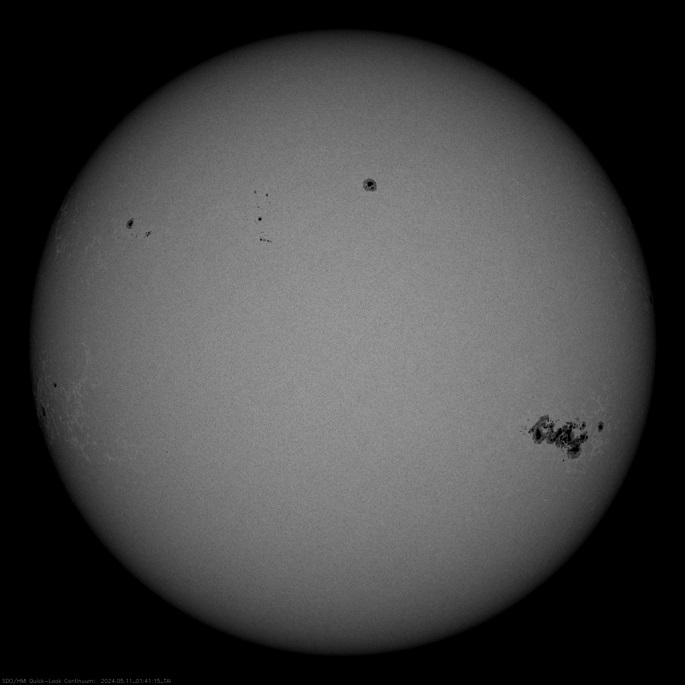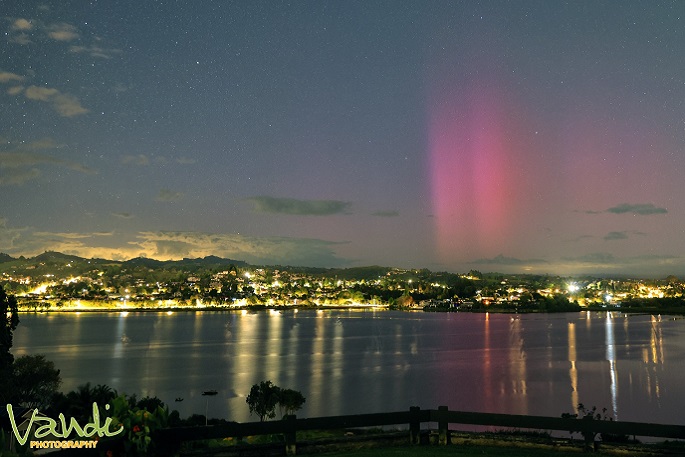As night falls this evening, anticipation will be mounting amongst Tauranga's astronomers and skywatchers as they wait to see if the Southern Lights, known as Aurora Australis will be viewable.
This rare display of shimmering lights dancing across the southern horizon is a spectacle rarely seen here. It is helped by an exceptionally large group of sunspots that have been active in recent days, unleashing several earth-directed Coronal Mass Ejections, also known as CMEs.
The Aurora Australis is a celestial dance of light caused by the interaction of charged particles from the solar wind with interplanetary magnetic fields and atmosphere.
These charged particles, mainly electrons and protons, collide with gases in the Earth's atmosphere, producing vibrant hues of green, pink, purple, and red that paint the night sky.
Tauranga Astronomical Society president David Greig says these CMEs are expected to arrive over the weekend, potentially producing spectacular auroral displays in our southern skies.
“This is nothing to be concerned about, it is a good opportunity to possibly see the Aurora Australis.”
David says the sun spot cycle and solar activity peaks approximately every 11 years.
“And we are nearing maximum activity,” says David.
The creation of the sunspots leads to increased solar wind, resulting in the captivating aurora. The last solar cycle peak occurred in 2013, and the next peak, aligning with the 11-year solar cycle is happening from 2023-2025.
The rare event comes as Transpower has issued a “grid emergency” notice due to a severe storm in space.
A spokesperson for the agency, which operates the New Zealand power grid, says a geomagnetic storm is likely to affect Earth over this weekend because of significant solar activity.
David says that Coronal Mass Ejections, also known as CMEs are unpredictable but occur more frequently when there are a lot of, or large sunspots visible.
“Aurora activity seems to be more likely around the equinoxes in March and September,” says David.
To possibly see the aurora, wherever you are, you will need to be looking south, preferably from a dark location away from any bright lights,” says David.
“The aurora is best seen from further south, for example, the lower South Island.
“But during extreme aurora activity, it is possible to see, or at least photograph the aurora from much further north, including from the Bay of Plenty, Waikato and Auckland.”
Local photographer John van der Broek of Vandi Photography photographed the Aurora Australis from his home in Maungatapu in November, 2023, capturing the Southern Lights above the lights of Tauranga city before dawn. He plans to wait for the next magical moment again, from the same location.
SolarHam.com provides real time space weather news and data from various sources, and was created and is still maintained solely by amateur HAM radio station Kevin VE3EN. The site reported on Saturday morning, NZ time about the space storm it was tracking.
"For the first time since the great Halloween Storm of 2003, the Extreme (G5) Geomagnetic Storm threshold has been reached," says a SolarHam.com spokesperson.
On Saturday afternoon, David is following predictions on when the aurora activity is expected to be seen.
"At this stage I'm still waiting to see if the predicted peak is still going to be between six and nine pm this evening. The auroral activity really started to kick off this morning at about 6am just before sunrise," says David.
"You can find the very latest image of the sunspot group here, from the NASA Solar Dynamics Observatory which orbits the Earth.
"That big sunspot group is approx 200,000km in width. The Sun is 1.39 million km in diameter.
“For up to date info, I recommend following the NZ aurora Australis pages on Facebook," says David.

Saturday's image of the sun showing the large sunspot group which is approximately 200,000km, taken by the NASA Solar Dynamics Observatory which orbits the Earth. Photo: NASA.
David's recommendations to follow:
Aurora Australis NZ Facebook page
New Zealand Aurora Australis Group Facebook page
With ideal viewing conditions forecasted, tonight promises a breathtaking show as nature once again paints the heavens with vibrant hues.



0 comments
Leave a Comment
You must be logged in to make a comment.